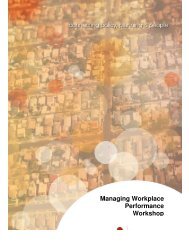Teenage Pregnancy Research Report - 3p Consulting
Teenage Pregnancy Research Report - 3p Consulting
Teenage Pregnancy Research Report - 3p Consulting
Create successful ePaper yourself
Turn your PDF publications into a flip-book with our unique Google optimized e-Paper software.
Education outcomes duringpregnancyYoung maternal age is overwhelmingly linked with lowsocio-economic status and education and this is seen byboth policy makers and pregnant teens themselves as akey avenue to move from a position of disadvantage intoemployment and income self-sufficiency. The UK studymentioned above found that some teens they spoke withsee their pregnancy as a “trigger event” to make changesin their lives and plan for the future by re-engaging witheducation. 3 However, as indicated in the South AustralianHealthy Young Parents in Education report in 2007, inreality many pregnant teens do not continue or re-engagein education as...“the lack of support means that thesewomen often fail in this pursuit”. 4Education attainment rates help give a picture of thereality of the educational outcomes of pregnant teensand parents. In the US for example, half of the youngwomen who were teen mothers received a high schooldiploma as compared to 89% of women who were notmothers. 5 Additionally educational achievement rateswere even lower for younger mothers (before 18 years)than if they were 18 years and above before parenting.Canadian data shows a similar pattern where the timingof motherhood was found to be significantly related tothe chances of finishing high school or post-secondaryeducation. 6From the evidence, why pregnant teens do not achieveacademically in the same way as their non-pregnant peerscan be summarised into three distinct areas involvingindividual factors, how education institutions incorporatepregnant teens into their system and education as apriority for intervention from service providers.To illustrate these points, we can draw on the findingsfrom the UK Sure Start Plus program evaluation report. 7The Sure Start Plus Program provided targeted andintensive support, across a range of outcome areas, topregnant and parenting teens.• How the circumstances of pregnancy and parentingimpact individually. Short-term plans often do notinvolve plans to participate in education, with 40% ofthe mothers interviewed in the year since becomingpregnant having no immediate plans to return to workor study.• Systemic barriers to continuing in education duringpregnancy and parenting. Targeted support was foundto increase school retention rates for those pregnantor parenting teenagers who were 15 or under (statuaryschool age) as targeted support increased participationrates to 83% when compared to a comparable controlgroup who had participation rates of 60%. Furthermorethis group continued their education without a breakand their education achievements matched their nonpregnantpeers. In contrast, the proportion of pregnantor parenting young people in education dropped to33% when they were 16 and 17 years; and to 22% forthose 18 years and older.• Education as a priority for service providers. Despitethe above achievements for those young people 15and under, service providers were initially very waryof focusing on education, believing that many youngwomen who became pregnant had a strong dislike ofschool and poor educational attendance prior to thepregnancy. As the report states: “They were concernedthat the reasons for educational dissatisfaction shouldbe addressed, rather than ‘forcing’ people back intoeducation to meet the target. They were concerned,also, about pursuing this target in relation to morevulnerable young women who had crisis issues toaddress and those who expressed a desire to be fulltimemothers”.Education and Teen pregnanciesin AustraliaWithin Australia there is a similar concern about the linkbetween poor school retention and engagement rates andlong-term outcomes for pregnant teens. Education is theresponsibility of state governments and there are variousstrategies to support young people at risk of disengagementand vulnerable youth, including pregnant teens.Most of the policy directions that focus on pregnancy arebased on the requirements of the Anti-DiscriminationAct 1991. 8 Section 21 of the Sex Discrimination Act1984 makes it unlawful for an educational authority todiscriminate against a person on the ground of pregnancy. 9However, Pregnant and Productive, the report of theNational <strong>Pregnancy</strong> and Work Inquiry conducted by theHuman Rights and Equal Opportunities Commission in1999, recommends that the Attorney-General amendssection 13 of the Act to remove the state instrumentalityexemption. 10 It also recommends that the Department ofEducation Training and Youth Affairs develop a pamphletof the Sex and Discrimination Act for secondary schoolstudents and produce materials for schools aboutmanaging the retention of pregnant students.The table on the following page outlines state educationpolicies in relation to supporting pregnant students.57



